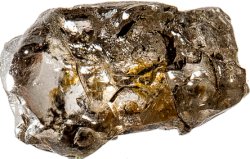
March Editorial
Water deep within the Earth?

March Editorial
Water deep within the Earth?
|
|
Diamonds form deep inside the Earth's mantle. Often during the process of crystallization fragments of other material from deep within the Earth are trapped and preserved inside the diamonds. When diamonds are brought to the surface through volcanic action those impurities give us valuable insights into geological processes in a part of our planet which is totally inaccessible to humans, and much more inhospitable than even deep space. |
|
|
The recent discovery of ringwoodite inside a diamond has now allowed scientists to confirm what they have theorised about for over half a century - that there are large reservoirs of water deep inside the Earth at the transition zone between the upper and the lower mantle - that is, in the area around 500 km (300 miles) below the earth's surface. The diamond in which this discovery was made was found in Juina, Brazil in 2008. It was embedded in kimberlite which is over 100 million year old. Originally the material was part of a separate project run by Prof Graham Pearson and his group at the University of Alberta in Canada. The stone itself is far from gemstone quality, and was originally purchased for the equivalent of $20. While analyzing this diamond, the researchers found a tiny sample of ringwoodite. Although the discovery was made in 2009, the sample then underwent years of analysis using Raman and infrared spectroscopy and X-ray diffraction before it was officially confirmed as ringwoodite. Ringwoodite is a high-pressure polymorph of olivine. But whereas olivine is most abundant in the upper mantle at the depth of about 410 km, ringwoodite is believed to reside in large quantities in the transition zone of the mantle between 410 and 660 km depth. One interesting thing about the chemistry of ringwoodite is that its structure contains water. The 'water' exists not as a liquid form but as hydroxide ions - oxygen and hydrogen bound together within the structure of the stone. Ringwoodite was originally found only in meteorites, originally in the Tenham meteorite in 1969. This is the first time that terrestrial ringwoodite has been discovered. Using infrared spectroscopy, Prof Pearson and his colleagues were able to confirm the water-rich nature of this diamond inclusion. The infrared absorption data showed that by weight the ringwoodite is about 1% water. This might not sound much, but extrapolate it to the transition zone of the mantle as a whole, it suggests oceans' worth of water. 'This sample really provides extremely strong confirmation that there are local wet spots deep in the Earth,' said Graham Pearson of the University of Alberta. 'That particular zone in the Earth, the transition zone, might have as much water as all the world's oceans put together.' Dr Pearson believes that the water found in the transition zone is recycled from the surface and may well be responsible for many of the Earth's tectonic and volcanic events. In his own words: 'One of the reasons the Earth is such a dynamic planet is because of the presence of some water in its interior.' Journal Reference: | |
| _______________________________ | ||||
| Home | | | Shopping | | | Database |
© Biscuit Software 2004-2015
All rights reserved